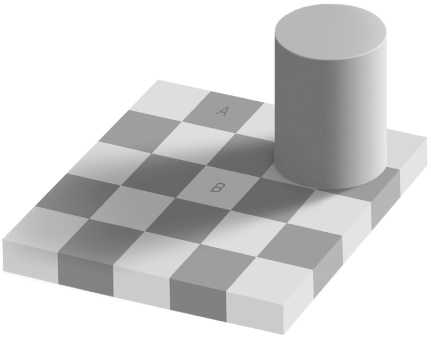Hack #23. See How Brightness Differs from Luminance: The Checker Shadow Illusion
A powerful illusion of brightness shows how our brain takes scene structure and implied lighting into account when calculating the shade of things.
A major challenge for our vision is the reconstruction of a three-dimensional visual world from a two-dimensional retinal picture. The projection from three to two dimensions irrevocably loses information, which somehow needs to be reconstructed by the vision centers in our brain. True, we have two eyes, which helps a bit in the horizontal plane, but the vivid self-experience of seeing a 3D world clearly persists after covering one eye [[Hack #22]].
In the process of reconstructing 3D from 2D, our brain cleverly relies on previous experience and assumptions on the physics of the real world. Since information is thus fabricated, the process is prone to error, especially in appropriately manipulated pictures, which gives rise to various large classes of optical illusions. We will concentrate here on a fairly recent example, Ted Adelson’s checker shadow illusion. 1
In Action
Take a look at Adelson’s checker shadow illusion in Figure 2-19.

Figure 2-19. Adelson’s checker shadow—which is brighter, A or B?
We would all agree that one sees a checkerboard with a pillar standing in one corner. Illumination obviously comes from the top-right corner, as the shadow on the checkerboard ...
Get Mind Hacks now with the O’Reilly learning platform.
O’Reilly members experience books, live events, courses curated by job role, and more from O’Reilly and nearly 200 top publishers.

